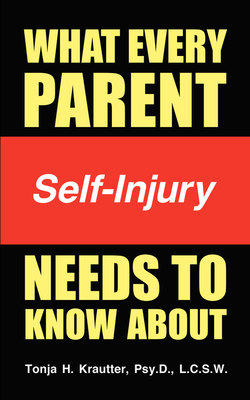Читать книгу What Every Parent Needs to Know About Self-Injury - Tonja Krautter - Страница 10
На сайте Литреса книга снята с продажи.
Why Does Self-Injury Feel Addictive
ОглавлениеSelf-injury is a coping mechanism that can feel addictive to the person who is doing it. When the individual self-injures, they experience a “rush” or “natural high.” This feeling stems from a physiological process; beta endorphins are being released into the brain. After the initial “rush,” the person finds herself in a peaceful and calm state of mind. This process is similar for individuals who exercise and experience the natural high that follows a good workout. These two feelings, the rush or natural high, followed by the state of calm, are what lead the person to engage in the behavior again and again. However, while the self-injurious behavior may feel very much out of the individual’s control, it is clearly something the person can control with proper treatment and intervention.
Self-injury is a behavior that is chosen to deal with intense distress. The individual feels that finding a solution, or at least a substitute behavior that does not include self-harm, is futile; a belief that is reinforced every time unpredictable, overwhelming feelings in daily life result in the decision to self-injure again. Elaine, for example, has struggled with self-injury for over a decade. She states, “Almost immediately, I was hooked. It was a hard habit to break because I liked the way it made me feel – completely at peace with myself. Any time I was sad, upset or angry, which was most of the time back then, I would cut to feel better.” Elaine cut herself every day, several times per day until she finally received treatment last year. She is now in recovery. She has not harmed herself in the past six months.
Many people who are recovered from self-injury still admit to feeling a desire to self-harm. It is not uncommon for these compulsions to be present for a long period of time following the last act of bodily harm. However, most individuals agree that, with time and intervention, the desires that they initially felt so strongly decrease in severity, duration, and frequency. Elaine, for example, reports that she had strong urges to self-injure for weeks after her last incident. She states, “At first it was all I could think about, but as time went on and I was able to tolerate my feelings better, my desire to cut decreased significantly. Now I rarely think about it at all.”
